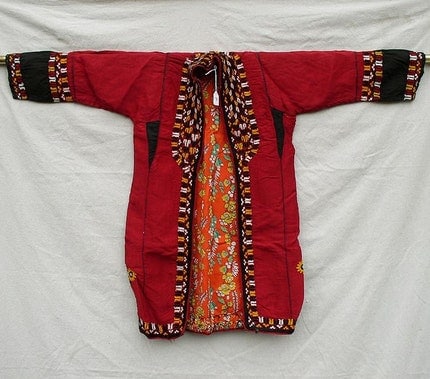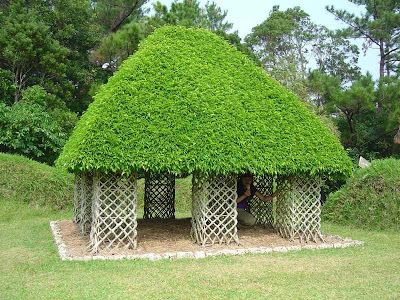 My local fiber art group, Paducah Fiber Artists, meets once a month for a pot luck, show and tell and general good fun. It's a monthly highlight for me. I arrived a bit late (as usual) to our June 2008 meeting to find this gorgeous woman sitting there. She was a guest artist from Portland, Oregon, spending a month at A.I.R. Studio located in the heart of Lowertown, our art district. Adriene Cruz embodies color, life, elegance, and texture, both in her persona as well as in her art. Her work has obvious African influence, but she incorporates pieces of textiles from around the world and their origins also add their voices to the final creation.
My local fiber art group, Paducah Fiber Artists, meets once a month for a pot luck, show and tell and general good fun. It's a monthly highlight for me. I arrived a bit late (as usual) to our June 2008 meeting to find this gorgeous woman sitting there. She was a guest artist from Portland, Oregon, spending a month at A.I.R. Studio located in the heart of Lowertown, our art district. Adriene Cruz embodies color, life, elegance, and texture, both in her persona as well as in her art. Her work has obvious African influence, but she incorporates pieces of textiles from around the world and their origins also add their voices to the final creation.  Adriene's website, which she claims is horribly outdated, gives continuity to her work. It is bright, decorated with borders taken from her textiles and filled with words of love and a vision of peace.
Adriene's website, which she claims is horribly outdated, gives continuity to her work. It is bright, decorated with borders taken from her textiles and filled with words of love and a vision of peace. Adriene is a transplant from New York, and although her heart is still there, she has become actively involved in Portland's community life. Their local PBS station, Oregon Public Broadcasting, has a program called Art Beat, which interviews local artists and then develops curriculum based for children based that artist's story.
Adriene is a transplant from New York, and although her heart is still there, she has become actively involved in Portland's community life. Their local PBS station, Oregon Public Broadcasting, has a program called Art Beat, which interviews local artists and then develops curriculum based for children based that artist's story.Adriene is there and her video will explain a lot of where she comes from, what inspires her and how she creates her pieces. If you have children or work with them, you might enjoy the three projects on Adriene's page as well as the other artists in the program. Lots of great ideas!
 Her community involvement has led her to collaborative work with other artists that have permanently changed Portland's landscape. She has worked on murals, billboards and other public art. The most impressive this train stop:
Her community involvement has led her to collaborative work with other artists that have permanently changed Portland's landscape. She has worked on murals, billboards and other public art. The most impressive this train stop:
The North Killingsworth Street MAX Station
Interstate Avenue at N. Kilingsworth
Portland, Oregon's public transit system, the MAX, is beautifying its stations through the designs of a variety of public artists. The North Killingsworth Street Station, which opened May 1, 2004, was developed through a mentorship between Adriene Cruz and design team artist, Valerie Otani.
 Adriene's work has been published in several books and her pieces are in private collections all over the world. The Exhibits and Honors page on her website lists the many prestigious places where her work has found a home or made an impact. Has this gone to her head? Nope. Adriene's feet are planted firmly on the ground. And her struggle to survive as an artist continues as a difficult, albeit joyous, path. I had the pleasure of visiting with her a bit at the studio while she was here. Her mother was also here, from New York, and I saw where Adriene learned her spirit of giving and love. Her Mom has the warmest, softest hands I have ever felt. Her smiles radiated benevolence, eyes sparkled with life.
Adriene's work has been published in several books and her pieces are in private collections all over the world. The Exhibits and Honors page on her website lists the many prestigious places where her work has found a home or made an impact. Has this gone to her head? Nope. Adriene's feet are planted firmly on the ground. And her struggle to survive as an artist continues as a difficult, albeit joyous, path. I had the pleasure of visiting with her a bit at the studio while she was here. Her mother was also here, from New York, and I saw where Adriene learned her spirit of giving and love. Her Mom has the warmest, softest hands I have ever felt. Her smiles radiated benevolence, eyes sparkled with life. If we are chips cut off from the block, Adriene's block has been solid and good. Speaking, or
If we are chips cut off from the block, Adriene's block has been solid and good. Speaking, or  writing, about cutting, Adriene has no fear in transforming textiles into something new. She bought a Turkmen coat from me very similar to the one on the left (available in my Etsy store, hint, hint), chopped it up and made a beautiful bag out of half of it. She had forgotten to bring one with her, so... no problem! Chop, chop, sew, sew, and there you go! Another accessory to complement her best art piece: her self!
writing, about cutting, Adriene has no fear in transforming textiles into something new. She bought a Turkmen coat from me very similar to the one on the left (available in my Etsy store, hint, hint), chopped it up and made a beautiful bag out of half of it. She had forgotten to bring one with her, so... no problem! Chop, chop, sew, sew, and there you go! Another accessory to complement her best art piece: her self! Adriene used the embroidery from the side of the coat as the front flap of her bag and incorporated the embroidery along the hem and front as the strap:
Adriene used the embroidery from the side of the coat as the front flap of her bag and incorporated the embroidery along the hem and front as the strap:
 I am inspired by artists and people like Adriene. They help build bridges among people and she has also contributed toward enhancing the physical space of her city. It makes me feel good to know that she is out there and the brief time I had with her here was a sunny day in Paducah!
I am inspired by artists and people like Adriene. They help build bridges among people and she has also contributed toward enhancing the physical space of her city. It makes me feel good to know that she is out there and the brief time I had with her here was a sunny day in Paducah!








































